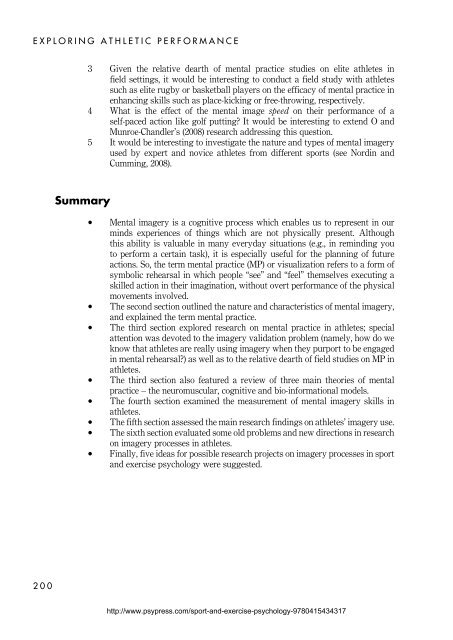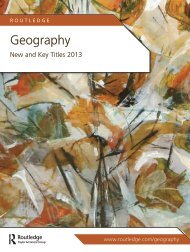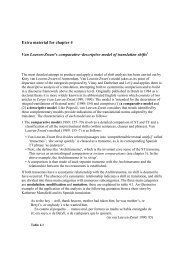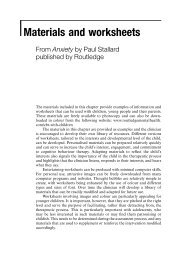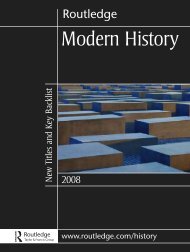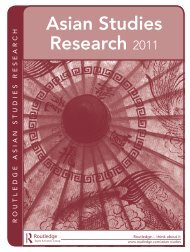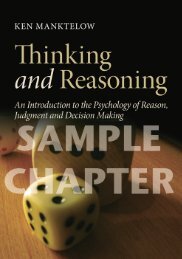Sport and Exercise Psychology: A Critical introduction ... - Routledge
Sport and Exercise Psychology: A Critical introduction ... - Routledge
Sport and Exercise Psychology: A Critical introduction ... - Routledge
Create successful ePaper yourself
Turn your PDF publications into a flip-book with our unique Google optimized e-Paper software.
EXPLORING ATHLETIC PERFORMANCE<br />
200<br />
Summary<br />
3 Given the relative dearth of mental practice studies on elite athletes in<br />
field settings, it would be interesting to conduct a field study with athletes<br />
such as elite rugby or basketball players on the efficacy of mental practice in<br />
enhancing skills such as place-kicking or free-throwing, respectively.<br />
4 What is the effect of the mental image speed on their performance of a<br />
self-paced action like golf putting? It would be interesting to extend O <strong>and</strong><br />
Munroe-Ch<strong>and</strong>ler’s (2008) research addressing this question.<br />
5 It would be interesting to investigate the nature <strong>and</strong> types of mental imagery<br />
used by expert <strong>and</strong> novice athletes from different sports (see Nordin <strong>and</strong><br />
Cumming, 2008).<br />
Mental imagery is a cognitive process which enables us to represent in our<br />
minds experiences of things which are not physically present. Although<br />
this ability is valuable in many everyday situations (e.g., in reminding you<br />
to perform a certain task), it is especially useful for the planning of future<br />
actions. So, the term mental practice (MP) or visualization refers to a form of<br />
symbolic rehearsal in which people “see” <strong>and</strong> “feel” themselves executing a<br />
skilled action in their imagination, without overt performance of the physical<br />
movements involved.<br />
The second section outlined the nature <strong>and</strong> characteristics of mental imagery,<br />
<strong>and</strong> explained the term mental practice.<br />
The third section explored research on mental practice in athletes; special<br />
attention was devoted to the imagery validation problem (namely, how do we<br />
know that athletes are really using imagery when they purport to be engaged<br />
in mental rehearsal?) as well as to the relative dearth of field studies on MP in<br />
athletes.<br />
The third section also featured a review of three main theories of mental<br />
practice – the neuromuscular, cognitive <strong>and</strong> bio-informational models.<br />
The fourth section examined the measurement of mental imagery skills in<br />
athletes.<br />
The fifth section assessed the main research findings on athletes’ imagery use.<br />
The sixth section evaluated some old problems <strong>and</strong> new directions in research<br />
on imagery processes in athletes.<br />
Finally, five ideas for possible research projects on imagery processes in sport<br />
<strong>and</strong> exercise psychology were suggested.<br />
http://www.psypress.com/sport-<strong>and</strong>-exercise-psychology-9780415434317


